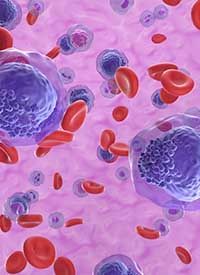News
Article
Fixed-Duration Data Foreshadow Earlier Use of Loncastuximab Tesirine in Relapsed/Refractory DLBCL
Author(s):
Loncastuximab tesirine-lpyl plus rituximab demonstrated promising antitumor activity and consistent safety signals in patients with relapsed/refractory diffuse large B-cell lymphoma.
Blood Cancer © laszlo - stock.adobe.com

Loncastuximab tesirine-lpyl (Zynlonta) plus rituximab (Rituxan; Lonca-R) demonstrated promising antitumor activity and consistent safety signals in patients with relapsed/refractory diffuse large B-cell lymphoma (DLBCL), according to updated data from the phase 3 LOTIS-5 trial (NCT04384484) that were presented at the 2023 SOHO Annual Meeting.1
As of the data cutoff date of April 10, 2023, with median follow-up of 10.8 months (range, 1.9-21.9), the overall response rate (ORR) was 80% (95% CI, 56.3%-94.3%), which included a complete response rate of 50% (95% CI, 27.2%-72.8%) and a partial response rate of 30% (95% CI, 11.9%-54.3%). The median duration of response (DOR) was 8.02 months (95% CI, 3.19-not reached [NR]), and median progression-free survival (PFS) was 8.31 months (95% CI, 4.53-NR).
“Although still early, the updated data from the safety run-in of the LOTIS-5 study look promising,” Michal Kwiatek, MD, PhD, medical director, Centrum Medyczne Pratia Poznan, Skorzewo, Poland and lead author of the LOTIS-5 abstract, stated in a news release on the data.2 “The combination of [loncastuximab tesirine] and rituximab is a systemic chemo-free regimen with a fixed treatment duration, making it an appealing alternative to continuous therapies.”
Relapsed/refractory DLBCL is associated with poor prognosis, but preclinical data suggest that adding rituximab to CD19-directed therapy such as loncastuximab tesirine may extend the duration of disease control.
Already approved for use as a monotherapy in patients with relapsed/refractory DLBCL who have received at least 2 prior lines of therapy, investigators evaluated loncastuximab tesirine in combination with rituximab in patients who have received at least 1 prior line of therapy in the randomized, open-label, 2-part, multicenter, confirmatory LOTIS-5 trial.
Previous results from the trial were presented at the 2022 SOHO Annual Meeting, with median follow-up of 5.83 months (range, 1.9-10.3).3
To be eligible for enrollment, patients must have received a pathologic diagnosis of relapsed/refractory DLBCL, including DLBCL transformed from indolent lymphoma or high-grade B-cell lymphoma with MYC and/or BCL6rearrangements; and documented CD19 expression if prior CD19-directed therapy was received. They could not have been a candidate for stem cell transplant based on performance status, advanced age, and/or significant medical comorbidities. Additional eligibility criteria included measurable disease per 2014 Lugano Classification criteria, ECOG performance status (PS) of 0 to 2, and adequate organ function.
Patients in part 1 received the combination and were evaluated for safety. Per protocol, patients received 0.15 mg/kg of loncastuximab tesirine plus 375 mg/m2 of rituximab every 3 weeks for 2 cycles, followed by 0.075 mg/kg of loncastuximab tesirine plus 375 mg/m2 of rituximab every 3 weeks for up to 6 cycles.
The primary end point was PFS assessed via independent central review. Secondary end points included overall survival, ORR, DOR, safety, pharmacokinetics, and changes in patient-reported outcomes.
A total of 20 patients were included in the safety run-in portion and had a median age of 74.5 years (range, 35-93). Patients had received a median of 1 prior line of therapy (range, 1-7), though 35% had received 2 or more. At data cutoff, patients had received a median of 5 doses (range, 1-8) of treatment.
Most patients were female (55%), had grade 1 ECOG PS (50%), stage IV disease (35%) per Ann Arbor criteria, and DLBCL not otherwise specified (90%). Additionally, most patients had not undergone prior stem cell transplant (95%), had relapsed disease to both frontline (90%) and last line (75%) therapy.
Regarding safety, all patients experienced at least 1 treatment-emergent adverse effect (TEAE), and 11 (55%) patients had grade 3 or greater TEAEs. The most frequent all-grade TEAEs were increased gamma-glutamyltransferase (25%), rash (25%), decreased appetite (20%), and fatigue (20%). The most common grade 3 or greater TEAEs were increased gamma-glutamyltransferase (25%) and neutropenia (15%).
Serious AEs occurred in 9 patients (45%). The most common serious AE was infection in 6 patients (30%), followed by 1 case each of hyponatremia, anaphylactic reaction, pleural effusion, malaise, and neurological decompensation.
A total of 8 patients died because of disease progression (n = 4), COVID-19 infection (n = 2), pancreatic neoplasia (n = 1), and stroke (n = 1). Most deaths occurred during follow-up (n = 7) as opposed to treatment.
“We are very pleased with the progress of our ongoing [loncastuximab tesirine] development programs. For LOTIS-5, the phase 3 study evaluating the combination of [loncastuximab tesirine] with rituximab, we are encouraged by the updated safety run-in results being presented at SOHO 2023. The data show signs of durable responses in patients with relapsed or refractory diffuse large B-cell lymphoma and, importantly, no new safety signals,” Mohamed Zaki, MD, PhD, chief medical officer of ADC Therapeutics,” said in a news release.2
The second phase of the trial began in January 2022 and recruitment remains open. In this phase, 330 patients will be randomly assigned to the same schedule of loncastuximab tesirine plus rituximab, or 375 mg/m2 of rituximab plus 1000 mg/m2 of gemcitabine and 100 mg/m2 of oxaliplatin every 2 weeks for up to 8 cycles.
References
- Updated results of the safety run-in of the phase 3 LOTIS-5 trial: novel combination of loncastuximab tesirine (Lonca-R) versus immunochemotherapy in patients with R/R DLBCL. Presented at: Society of Hematologic Oncology 2023 Annual Meeting; September 6-9, 2023; Houston, TX. Abstract ABCL-515.
- ADC Therapeutics announces updates on Zynlonta LOTIS clinical trial programs at the eleventh annual meeting of the society of hematologic oncology (SOHO 2023). News release. ADC Therapeutics. August 30, 2023. Accessed September 8, 2023. https://ir.adctherapeutics.com/press-releases/press-release-details/2023/ADC-Therapeutics-Announces-Updates-on-ZYNLONTA-LOTIS-Clinical-Trial-Programs-at-the-Eleventh-Annual-Meeting-of-the-Society-of-Hematologic-Oncology-SOHO-2023/default.aspx
- Kingsley E, Grosicki S, Kwiatek M, et al. Initial safety run-in results of the phase 3 LOTIS-5 trial: novel combination of loncastuximab tesirine with rituximab (Lonca-R) versus immunochemotherapy in patients with R/R DLBCL. Presented at: 2022 SOHO Annual Meeting; September 28-October 1, 2022; Houston, TX. Abstract ABCL-320.









